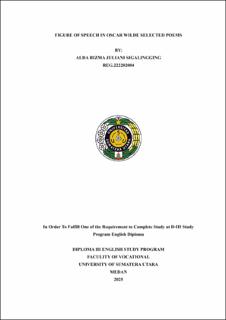Bahasa Kiasan dalam Puisi-puisi Terpilih Karya Oscar Wilde
Figure of Speech in Oscar Wilde Selected Poems

Date
2025Author
Sigalingging, Alda Rizma Juliani
Advisor(s)
Lubis, Swesana Mardia
Metadata
Show full item recordAbstract
Background: A figure of speech is a style of language that uses words or phrases with meanings that are not literal. It enhances the emotional and artistic expression in literary works, especially poetry.
Research objectives: This study aims to describe the various types and importance of figures of speech. It also examines the language style used in Oscar Wilde's poems. The research illustrates the types and interpretations of figures of speech found in Wilde's works.
Method: This study employs a descriptive qualitative method. The data were collected through library research and analyzed using Perrine’s theory of figures of speech. The researcher examined five poems by Oscar Wilde: To My Wife, My Voice, Her Voice, Serenade, and Endymion.
Results: The analysis revealed 47 occurrences of figures of speech across the poems. These include 9 personifications, 3 similes, 5 metaphors, 5 apostrophes, 4 synecdoches, 4 metonymies, 9 symbols, 2 paradoxes, 2 hyperboles, 1 understatement, and 3 ironies. Each type was identified, interpreted, and contextualized based on the content of each poem.
Conclusion: The study concludes that figures of speech in Oscar Wilde’s poetry contribute significantly to the emotional and symbolic depth of his works. The most frequently found figures were personification and symbol. These elements help express themes of love, memory, beauty, and melancholy. By interpreting figures of speech, the researcher gained a deeper understanding of Wilde’s poetic intentions and themes.
Keywords: Figure of Speech, Oscar Wilde, Perrine’s Theory.
Collections
- Diploma Papers [199]
